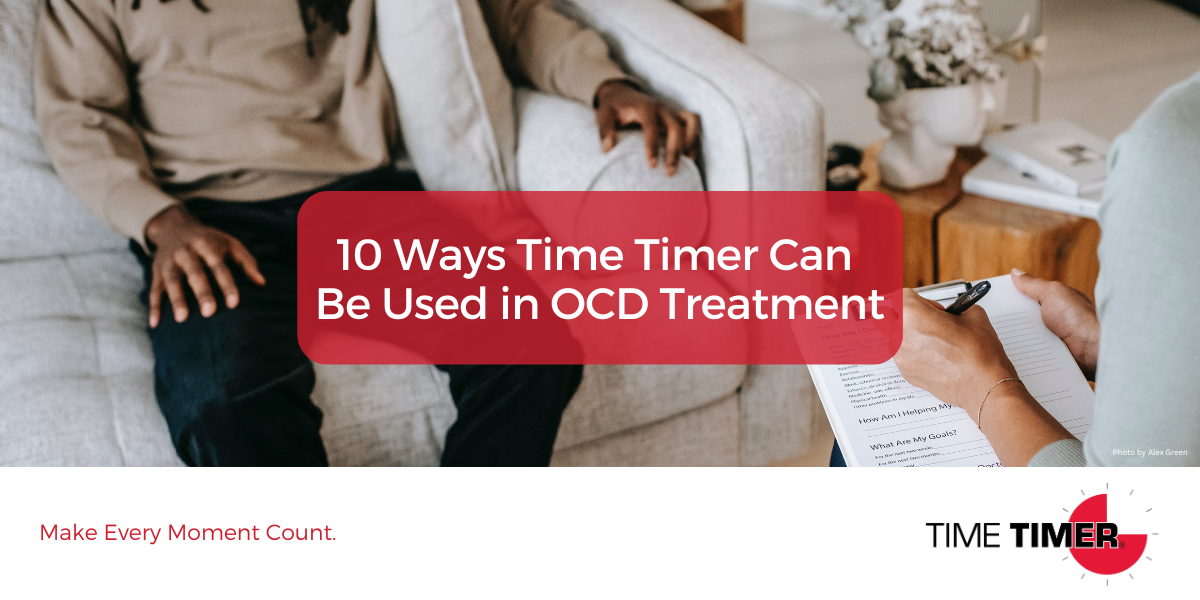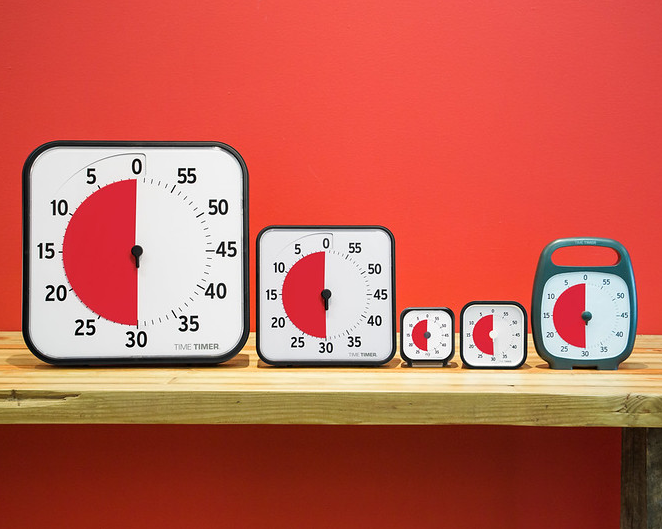
Do you feel like your obsession with “the right time” and time management prevents you from getting anything done? Does being “late” to work, school, appointments, meetings, dates, etc., cause you to feel stressed and anxious? Do you often feel “rushed” to complete tasks, and if you feel “rushed” does this feeling trigger or worsen your OCD symptoms? Are you constantly asking or wanting to know what time it is? And, when there is a change of plans, do you become extremely frustrated to the point of giving up? If the answer to any of these questions is “YES,” help is on the way! Time Timer visual timers may be just what you need to get your life back on track!
What is OCD?
Obsessive-compulsive disorder (OCD) is a mental health condition that involves involuntary and intrusive thoughts, urges, visions, fears (obsessions), and/or repetitive rituals or routines (compulsions). OCD is a common mental health disorder that involves a cycle of stress and anxiety followed by obsessions and/or compulsions. Because anxiety plays a significant role in this disorder, it is also considered an anxiety condition. OCD typically presents between the ages of 10 and 23, however, it can arise earlier or later than this timeframe. There are many types of OCD, ranging from hoarding OCD and relationship OCD to suicidal OCD and contamination OCD.
OCD is a lonely, but powerful disorder that does not discriminate against people based on their age, gender, socio-economic status, educational background, race, culture, location, ethnicity, religion, or sexual orientation. The good news is it can be successfully managed using a multi-treatment approach, involving psychotherapy, like cognitive-behavioral therapy (CBT) or exposure-response and prevention (ERP) therapy, medications like SSRI antidepressants, self-help tools and Time Timer visual timers, an intuitive assistive device designed to help people complete tasks and accomplish their goals.
What is a Time Timer® Visual Timer?
Created 25 years ago, by Jan Rogers, Time Timer was designed to help people of all ages and abilities visually “see” time. Thus, the goal of Time Timer is to boost one’s focus, concentration, and ability to self-regulate by aiding in and supporting smooth transitions (i.e., moving from one task or routine to another).
The passage of time, especially when linked to “lateness” or “feeling rushed” can trigger or worsen anxiety in some people, especially in those who struggle with OCD. When OCD sufferers feel “late” or “rushed,” they become stressed and anxious, which can lead to a re-emergence or worsening of OCD symptoms. Time Timer prevents this cycle of stress and anxiety, obsessions, and/or compulsions by “showing” the passing of time in a more concrete way – a clockwise red disk that disappears as time elapses.
Regardless of if your obsessions involve an overwhelming fear of contamination and a compulsion that involves washing and re-washing your hands until you feel clean, Time Timer can help. The Time Timer WASH can help you stop engaging in compulsions like excessive hand-washing, while the Time Timer – Original can help you with other OCD symptoms. The best thing about Time Timer is that it can be used in a variety of settings and in a variety of ways, such as in the classroom, at home, and even at work to ease transitions and support autonomy, and productivity!
10 Ways Time Timer Can Be Used in OCD Treatment
While studies suggest that psychotherapy and medication are the most effective ways to treat OCD, sometimes more is needed to help OCD sufferers get back on track and resume their lives. That is where self-help tools come into play. Because OCD is linked to time-management issues, having a timer on hand to help keep people on task just makes sense! The benefits of using a Time Timer are numerous, but listed below are ways that this device can be used to treat OCD.
Listed below are 10 ways Time Timer visual timers can be used in OCD treatment:
- Time Timer visual timers actually “show” the passage of time, for instance, it can “show” you how long you have been engaged in an obsession (i.e., the dirt, germs, harm, mistakes, etc.) or ritual or routine (washing your hands, checking things, etc.).
- Time Timer visual timers can help you stay on track by visually “showing” you how much time you have left to complete daily or important tasks. If you look at the timer and time is running low, it can serve as a visual cue that you need to stop engaging in your obsessions and/or compulsions and complete your tasks.
- Time Timer visual timers help you leave in time for school or work. Knowing how much time you have to get up, take a shower, get dressed, eat breakfast, and get to school or work on time can prevent you from getting wrapped up in an OCD loop of obsessions and/or repetitive behaviors, so you are not late. In other words, it can keep you focused.
- Time Timer visual timers set realistic expectations on how long to perform a certain action. For instance, the Time Timer WASH helps OCD sufferers who excessively wash their hands comply with COVID guidelines or recommended cleaning practices without going to the extreme, like repeatedly washing their hands until they bleed. This device provides “rules” for how long it should take for each stage of the hand-washing process. The default is 30 seconds broken into steps – Soap (5 seconds), Scrub (20 seconds), and Rinse (5 seconds).
- Time Timer visual timers are accessible which means you can carry it with you wherever you go – i.e., to school, work, or even on outings with friends. The goal is to help you stay on track, so you are not, for instance, late for a doctor’s appointment, a meeting at work, or a test or exam at school because of your obsessions and/or compulsions.
- Time Timer visual timers are structured so you have little-to-no time to obsess over a thought, fear, urge, ritual, or routine. There are things you must get done in a certain amount of time so you do not have time to be consumed with your obsessions and/or compulsions.
- Time Timer visual timers can help you become or stay organized by breaking tasks into manageable pieces so you do not get hung up on one item or task. It keeps you moving and because you are not spending a large amount of time on one task, you can accomplish your goals for the day.
- Time Timer visual timers prevent you from becoming stressed and overwhelmed by the number of things you need to do for the day by helping you plan your day. Less stress leads to less anxiety, which leads to fewer OCD symptoms.
- Time Timer visual timers help you build, rebuild, and maintain strong relationships. Because people with OCD tend to become consumed with obsessions and/or compulsions, it is common for relationships to decline. This device helps you develop, rebuild, and maintain relationships by ensuring that you spend quality time with your loved ones.
- Time Timer visual timers can empower you! Because you are able to make improvements in various parts of your life, you feel better about yourself and your condition. If you are not seeking treatment, it could motivate you to do so!
References
- Del Casale, A., Sorice, S., Padovano, A., Simmaco, M., Ferracuti, S., Lamis, D. A., Rapinesi, C., Sani, G., Girardi, P., Kotzalidis, G. D., & Pompili, M. (2019). Psychopharmacological treatment of obsessive-compulsive disorder (OCD). Current Neuropharmacology, 17(8), 710–736. Retrieved from https://doi.org/10.2174/1570159X16666180813155017


